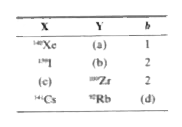A generic fission event is
235U+n→X+Y+2n
Which of the following pairs cannot represent X and Y: (a) 141Xe and 93Sr (b) 139Cs and 94Rb (c) 156Nd and 79Ge d. 121In and 113Ru?
The correct Answer is:b and c
To solve the problem, we need to analyze the fission event represented by the equation:
235U+n→X+Y+2n
In this reaction, the total mass number on the left side must equal the total mass number on the right side.
1. Calculate the total mass number on the left side:
- The mass number of 235U is 235.
- The mass number of the neutron (n) is 1.
- Therefore, the total mass number on the left side is:
235+1=236
2. Calculate the total mass number on the right side:
- The right side consists of the mass numbers of X, Y, and 2 neutrons (2n).
- The mass number of the two neutrons is 2×1=2.
- Thus, the total mass number on the right side is:
mass(X)+mass(Y)+2
3. Set up the equation:
- For the reaction to balance, we set the left side equal to the right side:
236=mass(X)+mass(Y)+2
- Simplifying this gives:
mass(X)+mass(Y)=236−2=234
4. Evaluate each option:
- Option (a): 141Xe and 93Sr
141+93=234(valid)
- Option (b): 139Cs and 94Rb
139+94=233(invalid)
- Option (c): 156Nd and 79Ge
156+79=235(invalid)
- Option (d): 121In and 113Ru
121+113=234(valid)
5. Conclusion:
- The pairs that cannot represent X and Y are:
- (b) 139Cs and 94Rb
- (c) 156Nd and 79Ge
Thus, the final answer is that options (b) and (c) cannot represent X and Y.
---
- The mass number of 235U is 235.
- The mass number of the neutron (n) is 1.
- Therefore, the total mass number on the left side is:
235+1=236
- The right side consists of the mass numbers of X, Y, and 2 neutrons (2n).
- The mass number of the two neutrons is 2×1=2.
- Thus, the total mass number on the right side is:
mass(X)+mass(Y)+2
- For the reaction to balance, we set the left side equal to the right side:
236=mass(X)+mass(Y)+2
- Simplifying this gives:
mass(X)+mass(Y)=236−2=234
- Option (a): 141Xe and 93Sr
141+93=234(valid)
- Option (b): 139Cs and 94Rb
139+94=233(invalid)
- Option (c): 156Nd and 79Ge
156+79=235(invalid)
- Option (d): 121In and 113Ru
121+113=234(valid)
- The pairs that cannot represent X and Y are:
- (b) 139Cs and 94Rb
- (c) 156Nd and 79Ge
Topper's Solved these Questions
- THE NUCLEUSBOOK - RESNICK AND HALLIDAYCHAPTER - THE NUCLEUSEXERCISE - PROBLEMS
66 Videos
- THE NUCLEUSBOOK - RESNICK AND HALLIDAYCHAPTER - THE NUCLEUSEXERCISE - PRACTICE QUESTIONS (Single Correct Choice Type)
69 Videos
- THE NUCLEUSBOOK - RESNICK AND HALLIDAYCHAPTER - THE NUCLEUSEXERCISE - PRACTICE QUESTIONS(Integer Type)
7 Videos
- THE KINETIC THEORY OF GASESBOOK - RESNICK AND HALLIDAYCHAPTER - THE KINETIC THEORY OF GASESEXERCISE - PRACTICE QUESTIONS
72 Videos
- UNITS AND MEASUREMENT BOOK - RESNICK AND HALLIDAYCHAPTER - UNITS AND MEASUREMENT EXERCISE - PRACTICE QUESTIONS (MATRIX-MATCH)
11 Videos
Similar Questions
Consider the fission reaction
.235U+n→X+Y+2n
Rank the following possible nuclides for representation by X (orY), most likely first:
(a) .152Nd, (b) .140I, (c) .128In, (d) .115Pd, (e) .105Mo
View SolutionWhich of the following points belong to the region represented by the inequations 2x−3y≥5andx−2y≤3 ?
(a) (3, 0)
(b) (−4,−4)
(c) (3,−5)
(d) (2,−2)
(e) (5, 1)
View Solution
Knowledge Check
You have learnt that a travelling wave in a dimension is represented by a funcation y=f(x,t) where x and t must appear in the combination x−vt or x+vt, i.e y=f(x±υt). Is the coverse true? (Examine if the following funcations for y can possibly represent a travelling wave :
(a) (x−vt)2
(b) log[(x+v)/x0]
(c) 1/(x+v)AOnly (a)B(b) & (c)C(c) & (d)DOnly (c)
Which of the following ordered pairs (points) belong to the inequation 3x−4≤4y−7 ?
(a) (2, 3)
(b) (−2,−2)
(c) (0,0)
(d) (−1,1)
View Solutiona-d Complete the following table, which referes to the generalized fission reaction 235U+n→X+Y+bn.

View SolutionFor the curve 7x2−2y2+12xy−2x+14y−22=0. Which of the following is true?
(A) An ellipse (B) A hyperbola (C) A circle (D) Pair of straight lines
View SolutionFor the curve 7x2−2y2+12xy−2x+14y−22=0. Which of the following is true?
(A) An ellipse (B) A hyperbola (C) A circle (D) Pair of straight lines
View SolutionWhich of the following equation(s) is/are linear? (a)dydx+yx=lnx(b)y(dydx)+4x=0(c)(2x+y3)(dydx)=3y(d)N.O.T.
View SolutionCircle S is passing through (1,2) and (3,4) and its one of the diameter is x + y = 5 given by then which of the following CANNOT be the radius of circle S.
a) 2 b) 1
c) 3 d)1.5
View SolutionIf a function is represented parametrically be the equations x=1+(log)ett2;y=3+2(log)ett, then which of the following statements are true? (a)y''(x−2xy′)=y (b)yy′=2x(y′)2+1 (c)xy′=2y(y′)2+2 (d)y''(y−4xy′)=(y′)2
View Solution
